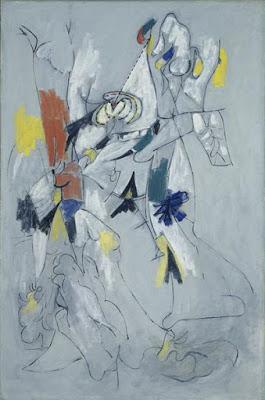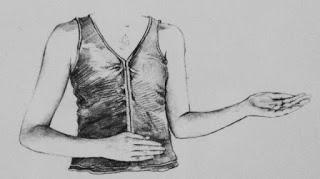
Waterfall by Arshille Gorky
This is part 3 in my series on the chakras. See Chakras: Guides on the Path to Healing to review the introduction to the series and Stand Your Ground with the Muladhara (Root) Chakra to read my post on Muladhara (Root) chakra. This post will cover Swadhisthana, the Sacral chakra.Traditionally, the chakra system is a meditation practice for nyāsa, which means ‘to place’ or take the mind to specific points in the body and then place a mantra, deity, or symbol at each energetic point. The science of tantra (about two thousand years ago) opened the door to viewing the chakras as a model of the human being and using the tools of hatha yoga to explore them. As 21st century yoga practitioners, we have a responsibility to honor the source of knowledge gifted to us from the Sanskrit texts and tantric traditions while making appropriate interpretations and modifications to fit our times, cultures and lifestyles.
From this contemporary perspective, we can view the chakras as a map for our journey through life as we evolve from basic needs toward a more subtle and spiritual understanding of existence. Joseph LePage says:
“At each step of the journey, the chakras describe an area of our lives for exploration, integration and transformation.”
The focus of the first chakra is on grounding, stability, safety, and security, which are qualities related to the earth element. The second chakra is associated with the water element and the focus is on feelings, movement, and sensation.
The Sacral chakra is said to be located four fingers-width below the navel and be related to the lower abdomen, sexual organs, reproductive glands, hips, and pelvis. It is suggested that here is where we work to sense, feel, and recognize our desires, creativity, and emotions, along with our need for pleasure and healthy sexuality. A key lesson is to release control over others in favor of gaining control over ourselves.
According to yoga tradition, imbalance in this energy may, like chronic stress, be a factor in low back, hip, and pelvic pain, sciatica, obstetrical and gynecological problems, sexual potency problems, or urinary problems. Stephen Levine in his book, Healing Into Life and Death, points out that grave injury and trauma in this area through sexual abuse, abandonment, or betrayal will take time and careful work to heal and may require professional help. So, our challenge is to embrace change, take personalized appropriate action, and manage life’s flow when it is pleasurable and when it brings difficult transitions, pain, and loss. It is important to understand that a total healing may not be possible. Anodea Judith makes this point in her book Eastern Body Western Mind:
“The second chakra is essentially a movement chakra which is never fully healed as it is constantly in a state of change. If there were a touchstone for a healed second chakra, it might be the ability to embrace change without losing one’s core stability.”
That’s a tall order, since life, like water, sometimes flows gently and sometimes requires us to navigate some pretty rough and tumble rapids.
Since there is no scientific way to understand the chakras, we will need to sharpen our ability to sense them with intuition and insight. According to Martha Graham, the mother of modern dance in America, “The body never lies.” Fortunately, we all have bodies and working with the body through yoga is an excellent way to become aware of the connection between our energetic and physical anatomies (see Chakras: Guides on the Path to Healing).
When I consider my ongoing work with second chakra issues, I find that movement is a natural pleasurable go-to solution. If I’m sluggish, feeling blue, or creatively stuck, I can get clarity and shift my energy by dancing, walking, doing yoga, going for a drive, or working out at the gym.
The lesson of releasing control over others in favor of gaining control over myself is another matter. My understanding of this issue came to fruition in my adult life as a reaction to difficult experiences with boyfriends, two husbands, and a few unfortunate work and social relationships. I experienced a lot of disappointment until I faced what I was doing wrong.
That realization came about while I was studying chakravidya (knowledge of the chakras), as part of my yoga therapy training. At the same time I was working my way through the aftermath of an emergency hysterectomy while in the middle of a difficult marriage. That perfect storm of circumstance helped me come to grips with and better understand what I sensed as a connection between my physical issues and the energetic issues in my Sacral chakra. Even now, when I scan my chakras, I can sense an imbalance and blockage in this area so I know that as a recovering co-dependent perfectionist (see Yoga Therapy for Perfectionism) I have more healing to do.
For a deep, user-friendly dive into the contemporary view of the chakras, I recommend Eastern Body, Western Mind by Anodea Judith. To work with your body and sense the energy of the sacral chakra, I recommend the following yoga practices.
Asana: Dynamic Cobra (Bhujangasana)
1. Come to the floor and take a hands and knees position, with your knees hips-width apart and your arms shoulder-width apart and outstretched.
2. Exhale as you sit back onto your heels in Child’s pose (Balasana) to generate a feeling of safety, security and self-nourishment.
3. Inhale and move through hands and knees position to lower yourself into your comfortable version of Cobra pose.
4. Exhale and push yourself up to your hands and knees and sit back into Child’s pose.
5. Pick a pace and rhythm that is comfortable for your body as you move through the flow.
6. Repeat at your chosen pace for 30 seconds to a minute or more.
Pranayama: Watching the Flow of the Breath
This should take no more than 2 to 3 minutes and can be done several times throughout the day.
1. Bring yourself to comfortable position, either seated or lying down.
2. Bring your attention to your breath and the fact that you are breathing.
3. Notice your breath and the flow of its four parts:
- Watch your inhalation
- Notice the slight pause before your exhalation
- Watch your exhalation
- Notice the slight pause before the next inhalation
Mudra: Swadhisthana Mudra

1. Place your right hand over your lower abdomen, with your thumb resting just below your navel.
2. Cup your left hand and hold it facing upward at the level of your navel and slightly angled to the left of your body, with your forearm parallel to the earth.
3. Soften your shoulders and allow you spine to be naturally aligned.
4. As your hold the mudra, watch for sensations like pulsing, tingling, or feelings of movement within your body.
5. Hold for 5 to 10 breaths or longer if you are comfortable.
Affirmation
The following affirmation be repeated on its own at any time or while practicing Dynamic Cobra or holding Swadhisthana mudra:
“With awareness and balance I go with the flow of life.”
Subscribe to Yoga for Healthy Aging by Email ° Follow Yoga for Healthy Aging on Facebook and Twitter ° To order Yoga for Healthy Aging: A Guide to Lifelong Well-Being, go to Amazon, Shambhala, Indie Bound or your local bookstore.
For information on Beth Gibbs' classes and upcoming workshops, see Beth's Classes and Workshops and for information about Beth, ProYoga Therapeutics, and Beth's book and CD, see proyogatherapeutics.com.

